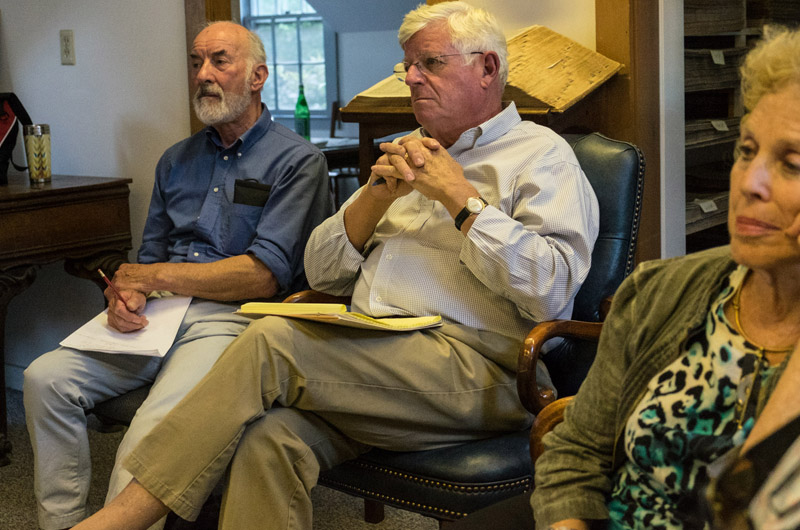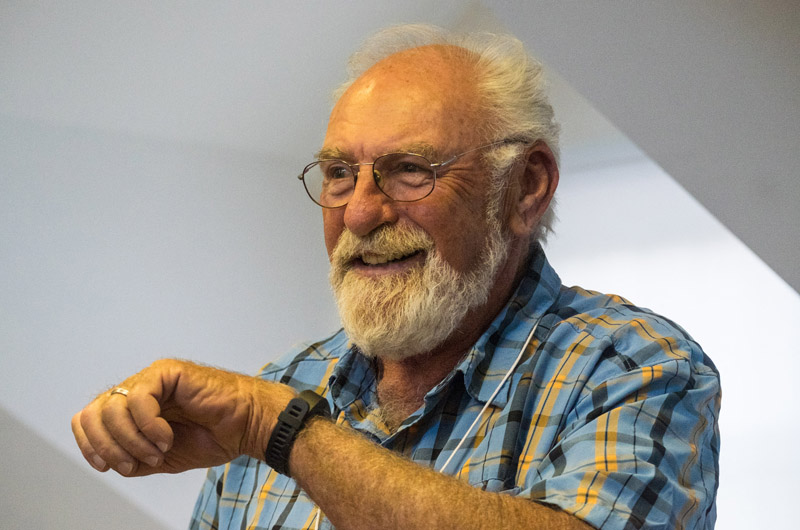The spread of disease-carrying ticks on Martha’s Vineyard is a mounting public health crisis that demands swift intervention and a unified approach, a leading field biologist and a longtime Island physician told a gathering of Islanders this week.
“Number one, we need to do something about deer ticks. Number two, we need to do something about Lone star ticks . . . . and I call deer the single source,” said Richard Johnson, a biologist who has been intensively studying ticks from Chappaquiddick to Aquinnah for the past five years under a grant from the Martha’s Vineyard Hospital.
“We are at the epicenter of Lyme disease in New England, and we have a responsibility to do something about it,” said Dr. Michael Jacobs, a retired internist who for more than 40 years was at the forefront of diagnosis and treatment of Lyme disease and other tick-borne illnesses.
Mr. Johnson and Dr. Jacobs were the featured speakers in the Gazette newsroom Tuesday during the first in a monthly off-season series sponsored by the newspaper. The event included the preliminary release of the results of a survey done by the Gazette in August in cooperation with the Martha’s Vineyard Boards of Health that gauges community attitudes about how to address the growing problem with ticks and tick-borne illness on the Vineyard. Among other things, the survey found strong support for culling the deer herd.
About 40 people attended the talk, moderated by Gazette publisher Jane Seagrave.
Mr. Johnson described in detail his work in recent years, funded by the hospital via the Island boards of health tick-borne illness prevention program. The work has included field studies of habitats and the collection of thousands of ticks from fields, woodlands, beaches and back yards. “If you want deer ticks, go up-Island. They like it wetter and follow the morainal habitat,” Mr. Johnson told the group. And while most people associate ticks with tall grass, common leaf litter found at the edge of fields and lawns provides an even more friendly habitat for deer ticks, he said.
He explained the life cycle of ticks (“mid- May to mid July is danger time”), and shared some results of his research, including the fact that one in four deer ticks collected from the field were found to be carrying Lyme disease. He advocated strongly for the use of the tick repellent Permethrin, modeling his own socks (with pants tucked in) embedded with the repellent and sold at many Island stores and garden centers.
“Practice safe gardening,” the veteran biologist advised.
He sounded an especially ominous note when speaking about lone star ticks, a southern species recently discovered here — on Chappaquiddick last summer and this summer in Aquinnah. Lone star ticks have eyes and can move fast and inflict a painful bite, Mr. Johnson said. Because they attach to birds, they can travel distances. And they carry their own diseases, including spotted fever, similar to Rocky Mountain spotted fever, an illness carried by dog ticks. Mr. Johnson said he knew of at least two conservation workers on Chappaquiddick who became ill this summer following exposure to Lone star ticks.
“Lone star ticks are going to be a game changer,” he declared.
Dr. Jacobs offered a detailed clinical perspective on the problem from his many years as a practicing physician on the Vineyard, bluntly noting the lack of consensus in the medical community about diagnosing and treating Lyme disease and other tick illnesses.
“We have a responsibility to do everything we can to educate the community about Lyme disease,” he said, drawing laughter at the outset when he suggested a modification to the popular Fitbit wrist device that could alert wearers to tick bites along with the number of steps traveled in a day. More seriously, he proposed harnessing the star power of celebrities who visit the Island — perhaps beginning with Richard Dreyfuss — to create an educational DVD about Lyme disease that he said might be called Little Jaws.
Dr. Jacobs said the transient nature of the Island complicates treatment of infections from tick bites. He said visitors to the Vineyard should be educated to alert their doctor if they if return home and become ill with flu-like symptoms. “Tell your physician you’ve been to Martha’s Vineyard,” he advised.
He said the Centers for Disease Control spells out clear protocols for the treatment of Lyme, including prophylactic treatment with two doxycycline tablets within 72 hours of a tick bite, and a full course of antibiotics once symptoms are present. Frustratingly, he said, the protocols are not followed consistently.
“I always said there is no such thing as summer flu on Martha’s Vineyard,” he said. “It’s Lyme disease. We have to educate ourselves, our visitors and our families.”
He explained that actual diagnosis of Lyme disease “is entirely clinical” and takes two weeks. “It’s a serious, serious disease. And there is some syndrome, post-treatment during which patients don’t fully recover.”
He admitted he had no immediate answer for how to get doctors on the same page.
And he praised the Island boards of health for their work on prevention efforts in the past five years, including the development of an educational website that appears to be not well known and under utilized. Edgartown health agent Matt Poole and Dr. Jim Butterick, who retired as chief medical officer of Cape Cod Healthcare and now serves on the Oak Bluffs board of health, also attended. Members of the audience asked questions, and with the hospital grant running out in December, discussion touched briefly on the need to find funding to continue Mr. Johnson’s work.
Both speakers underscored the urgency of the problem, noting that some of the efforts under way, including genetic modifications to white-footed mice, are promising but still years away. Mr. Johnson also said targeting mice alone is not enough. “People say, why not mice?” he said, explaining that there are so many more mice than deer, they are small and hard to find, and they breed prolifically several times a year. Plus, deer act as hosts for ticks during the critical reproductive cycle. “That’s where everything comes together,” he said.
Both Mr. Johnson and Dr. Jacobs said they are convinced that culling the deer herd on the Vineyard could make a deep dent in the problem in a short amount of time.
There is early precedent. On Monhegan island in Maine, a deer cull has drastically reduced the number of ticks. Closer to home, Dr. Butterick said on Naushon in the Elizabeth islands, the arrival of coyotes has nearly eliminated the deer, and dramatically reduced the disease-carrying tick population.
Mr. Johnson said logical next steps would include using available techniques to more precisely model the Island herd, currently estimated at 3,000 to 5,000 animals. The annual take from hunting ranges between 650 to 700 deer, he said. That number could increase with more private land opened to hunters and possibly a second hunting season.
As a wildlife biologist, Mr. Johnson said he did not arrive easily at the idea of culling the deer herd.
“I’ve spent my life protecting wildlife,” he said. “I like the deer; they are beautiful and I hate to stand here and say, we’ve got to kill the deer.”
He concluded:
“There is so much I’d like to know, and it may take awhile. But I don’t want to be here five years from now still be talking about how to reduce the deer.”










Comments (14)
Comments
Comment policy »